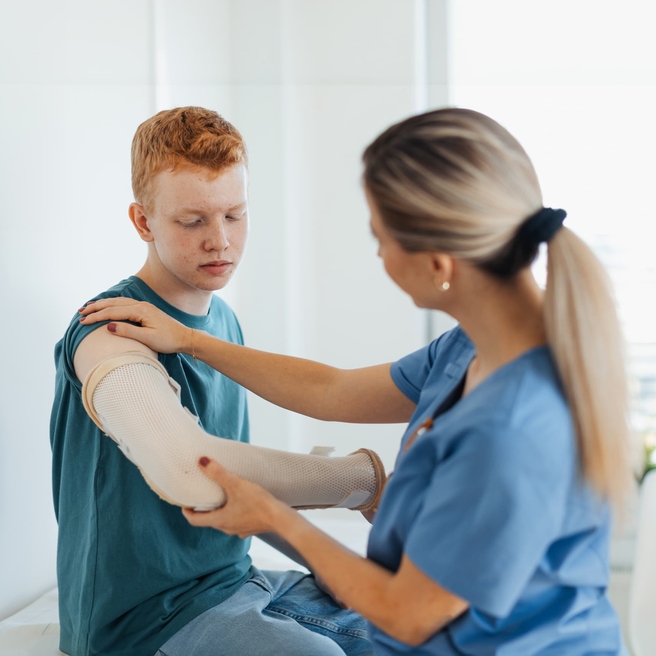What is a sprained ankle?
Ankle sprains are among the most common injuries in youth and usually occur when there’s a sudden movement or twist of the foot. This can result in overstretching the ligaments that help to stabilize the ankle joint. In most cases, ankle sprains occur when the ankle rolls to the outside while the foot goes to the inside, stretching one or more of the ligaments in the ankle. These are called lateral ankle sprains, and commonly occur during childhood, especially among youth athletes.
Three ligaments provide stability to the exterior ankle joint by limiting side-to-side movement. They are:
- Anterior talofibular ligament (ATFL), which joins the fibula to the talus bone (heel) in the front of the foot
- Calcaneofibular ligament (CFL), which joins the fibula to the talus bone on the side, near the ankle
- Posterior talofibular ligament (PTFL), which joins the fibula to the talus bone in the back of the foot
Most lateral ankle sprains affect the ATFL and CFL, ligaments that keep the ankle from sliding forward or rolling over. The severity of the ankle sprain depends on how many ligaments were involved and whether the ligaments were stretched, partially torn or completely torn.
Other types of less common ankle sprains include:
- Syndesmotic ankle sprains (commonly called “high ankle sprains”), which occur above the ankle joint, affecting the higher ankle ligaments
- Medial ankle sprains (commonly referred to as “eversion ankle sprains”), which are caused when the ankle rolls to the inside while the foot goes to the outside, affecting the deltoid ligament on the inside of the ankle.
Symptoms of a sprained ankle
Symptoms of a sprained ankle may include:
- Pain or soreness in the injured area
- Swelling in the injured area, which may develop in minutes or over several hours
- Joint stiffness
- Difficulty walking or moving the injured foot/leg in a normal manner
- Warmth, bruising or redness in the area (note that bruises may not appear for several days after the injury)
Diagnosing a sprained ankle
A sprained ankle is typically diagnosed after a physical examination by a pediatrician, orthopedic physician or sports medicine specialist. At Children’s Hospital of Philadelphia (CHOP), a physician will examine your child’s medical history, perform a physical examination and ask how the injury occurred.
In most cases, imaging tests will be ordered to confirm the diagnosis and support treatment decisions. An X-ray of the foot and ankle provides full visibility of bones and joints, while additional imaging, such as an MRI scan or CT scan, may provide more detailed information of the injured body part.
Treatment for a sprained ankle
Most treatment for sprained ankles is conservative and non-surgical and may include:
A CHOP sports medicine physical therapist and patient demonstrate Phase I of a home program at rehabilitate your foot or ankle following an injury.
- Rest to decrease swelling and avoid activities that cause pain. Patients may use crutches if needed to offload pressure on the injured leg.
- Apply ice to the injured ankle to dull pain and reduce swelling and inflammation every 2-4 hours as needed, for 20 minutes at a time. NOTE: do not place the ice or icepack directly on the skin; wrap in a towel or cloth.
- Compression to reduce swelling and stabilize the ankle joint. It’s important not to wrap the ankle too tightly. A walking boot or lace up ankle brace may be recommended.
- Elevation to raise the ankle, when possible, to reduce swelling.
- Over-the-counter medicines, such as ibuprofen or naproxen, to reduce inflammation and treat pain.
- Early physical therapy to promote healing and increase range of motion. This may include prescribed exercises to do at home. Therapy can play a role in repeat injury prevention.
Avoid heat (hot baths or heat packs) and massage, as these will increase blood flow to the area and may make swelling worse.
In most cases, pain and swelling from an ankle sprain will improve in 2-3 days with treatment. Seek medical attention if the child is unable to put weight on the injured ankle, pain is uncontrollable or if the injury is not improving.
A PT and patient from CHOP’s Sports Medicine and Performance Center demonstrate Phase II of a home rehabilitation program following a foot or ankle injury.
Athletes – especially dancers – require stability in their ankles to perform what is required of them. While most sprained ankles can be treated non-surgically, if ligaments are torn, scarred or overstretched, resulting in instability that affects their performance and ability to meet the demands of the sport, some athletes may be better served with surgery to stabilize the ankle. In these cases, surgery may be recommended. Surgery generally involves repairing the damaged ligaments.
Follow up care for a sprained ankle
In almost all cases, sprained ankles will heal over time with rest. To improve muscle strength and flexibility – and decrease the chance of reinjury – your child’s doctor or physical therapist may recommend the following:
- Stretching the muscles in the foot and ankle before any physical activity and repeating these stretches to cool down after strenuous activity such as a competition or performance.
- Increase the intensity of activity slowly. Don’t push too fast, too hard or too soon. Stop or pause activity that is causing pain.
- Participate in a variety of physical activities or different types of sports so the same muscles are not overstressed in the same way from repeated motions.
Ankle exercises you can do at home:
- Draw foot circles in the air with the affected foot. Repeat 10 times.
- Sitting or lying on the floor, use the ankle joint to push the foot up and down 10 times (i.e., pointing to sky, pointing to wall).
- Sitting in a chair, use the foot and ankle only to “trace” the letters of the alphabet in the air.
- Sitting on the floor with knee straight, use a cloth to gently pull the foot toward the calf until a stretch is felt. Hold the stretch for 30 seconds. Repeat three times. (If a cloth is not available, an adult can help the child keep the knee straight and gently pull the foot toward the calf, hold for 30 seconds and repeat three times.)

Why choose CHOP
We have more specially trained sports medicine physicians, orthopedic surgeons, physical therapists and athletic trainers than any other pediatric orthopedic facility in the region.
Resources to help
Sports Medicine and Performance Center Resources
We have created resources—including patient and family educational materials, videos, and more—to help you find answers to your questions and feel confident about the care you are providing your child.
